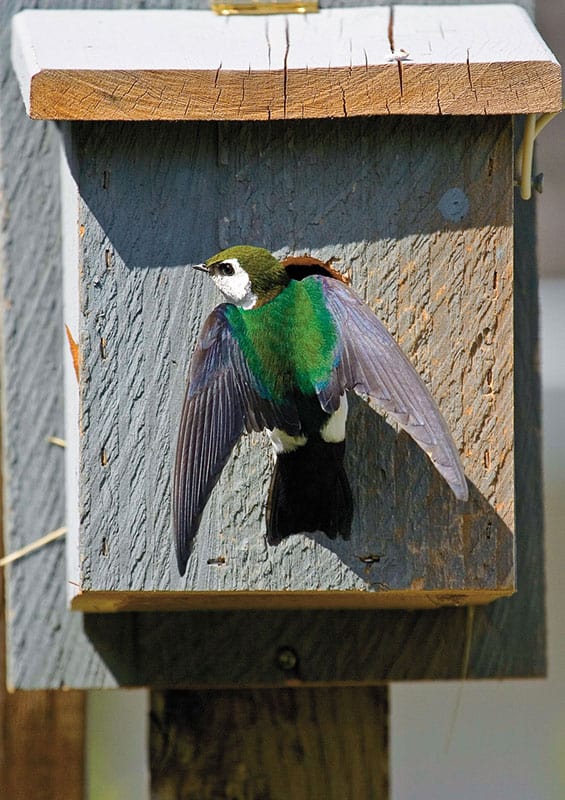
Here’s a non-toxic insect control approach that can work for anyone: Encourage insect-eating birds to move into your yards, pasture, and barn areas.
Many pest management techniques have toxic components, but here’s a non-toxic approach that can work for anyone: encourage insect-eating birds to move into your yards, pasture, and barn areas.This simple, easy, inexpensive method of pest control is about as green as you can get. At Sweet Pepper Ranch in Southwestern Idaho, we try our best to encourage swallows for fly and mosquito control.
Swallows, sweet little birds that gracefully dart about catching insects, provide excellent insect control. One swallow consumes many thousands of insects per day–a low-cost, non-toxic alternative to insecticides or bug zappers!
Several types of swallows are native to North America including violet-green swallows, tree swallows, barn swallows, bank swallows, cliff swallows, rough-winged swallows and purple martins. These voracious insect eaters spend winters in Central America with spring and summers in North America. Their slender little bodies are about five or six inches in length, with pointed wings and tails and fluid, quick flight paths. Colors vary slightly; violet-greens have white on their cheeks and flanks with greenish-blue wings and backs. Tree swallows have similar markings but with less white on their faces. The throat and undersides of barn swallows are reddish, with dark brown wings and backs. Cliff swallows are similarly marked, but duller in color.
Cliff and barn swallows build their own mud nests on the underside of roofs, overhands, bridges, cliffs or in barns. (If these little guys have nested where their droppings are making things messy, try placing a board under their nest to catch droppings, or put newspaper on the floor below. Violet-green and tree swallows are much cleaner than cliff and barn swallows.) Violet-green and tree swallows nest in already created holes and crevices such as those in dead trees and snags. Due to forestry practices of removing standing snags and dead trees, nesting sites for these birds have been reduced and their populations have been impacted. Fortunately, both tree and violet-green swallows will use nest boxes. By putting up nest boxes on your horse property you can help increase the swallow population and reduce your insect population at the same time. Breeding season begins about early May, but many times they raise a second clutch, so get your boxes up as soon as possible.
Nest boxes for violet-green and tree swallows are easy to build or buy and these birds are easily attracted to them. Nesting boxes must be specific to the type of swallows in your area. Poorly made boxes encourage non-native species, such as starlings, to move in which can out-compete swallows and other natives. To purchase or build the right nest box for the swallows in your area contact your local Audubon chapter or birding organization for advice on the types and sources of nesting boxes. Wild bird stores also have supplies and good information.
At Sweet Pepper Ranch we’ve been putting up nest boxes for tree swallows that summer in Idaho’s Treasure Valley. We also like to help the swallows gather their nesting materials by collecting horse and dog hair and setting them out in tuffs. In April, May, and early June, when swallows begin nesting in your area, you can watch them swoop down and snatch up the hair for nesting material. Each female swallow will lay about four to six eggs and will incubate them for about two weeks. Both the male and female care for the young which fledge in 16-24 days.
As land becomes more developed and dead trees that once provided nesting places are removed, the natural open space horse places offer can be an important haven for birds like swallows. By providing nest boxes, you can help swallow populations increase and make a huge dent in the numbers of insects around your property this summer. Here’s to a less buggy and less toxic summer ahead–let me know how this works for you!
Alayne
Author: Alayne Blickle
Link: https://thehorse.com/136130/free-non-toxic-insect-control-for-horse-properties/





